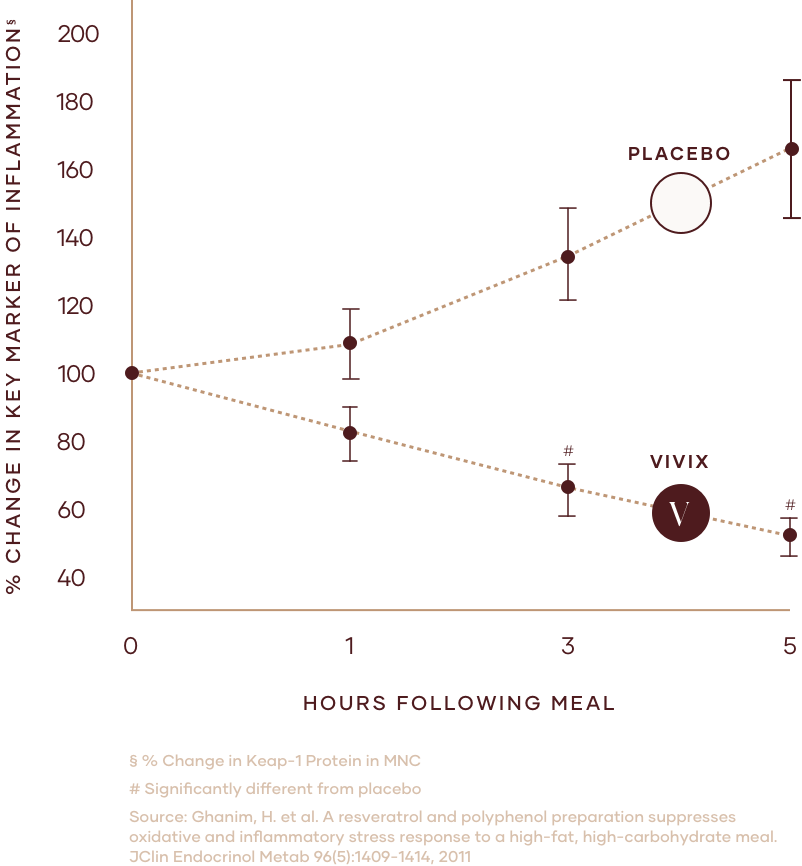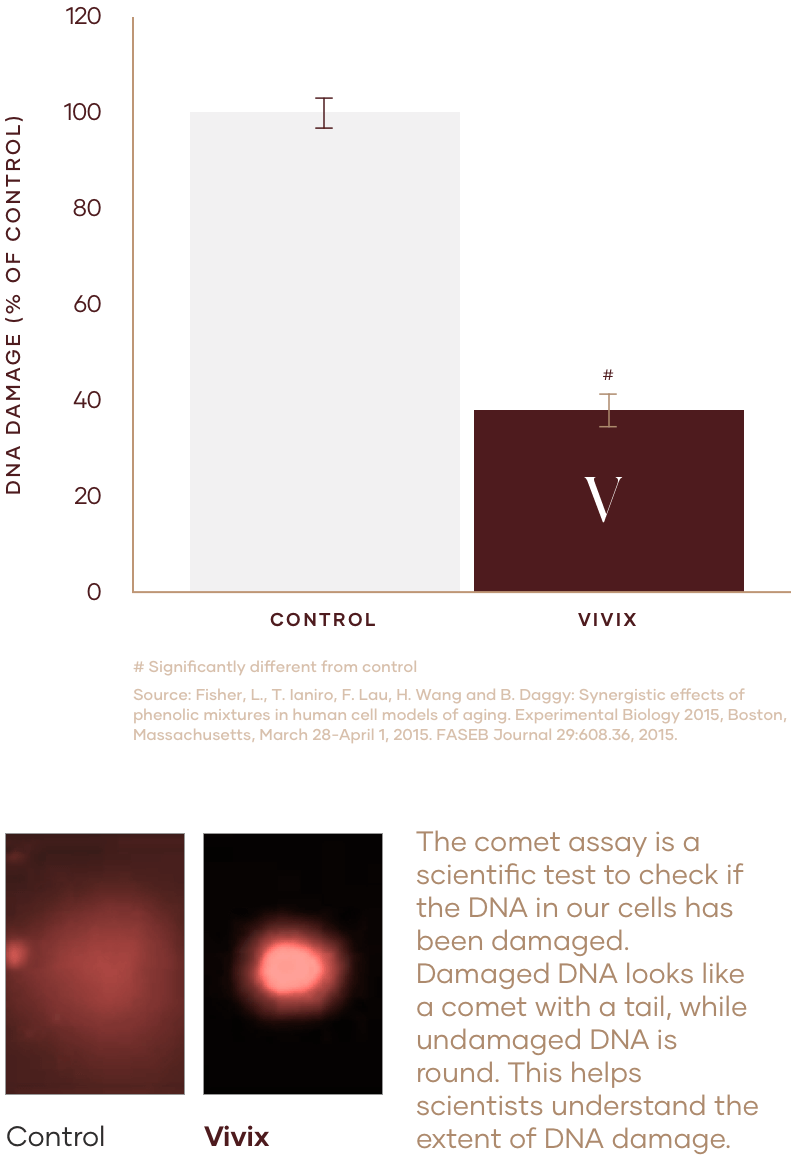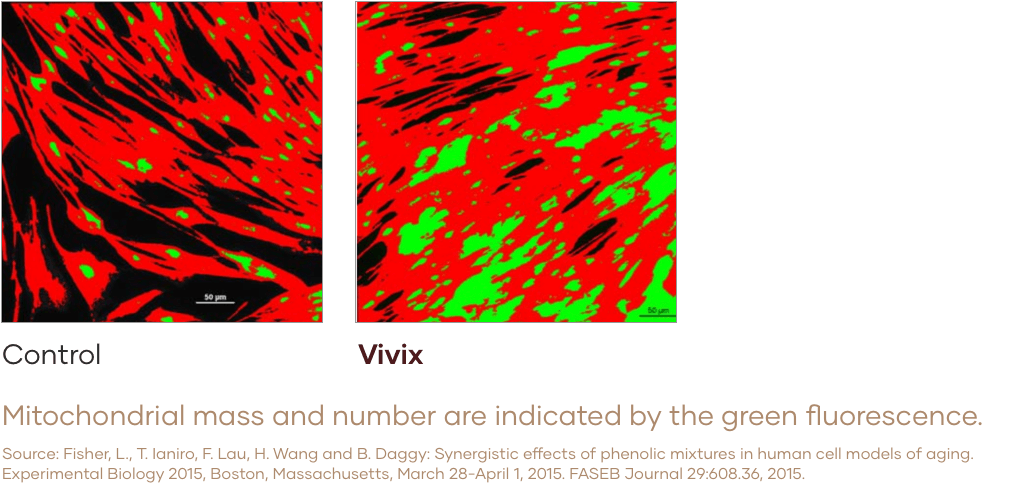The Science Behind Vivix®
Protect Against Oxidative Stress
and Neutralize Free
Radicals
What is oxidative stress?
Oxidative stress occurs when there's an imbalance between free radicals and antioxidants in the body. This can result in damage to cells and tissues and is a key component of the normal aging process.
So, what are free radicals? Where do they come from? And what can we do to neutralize them? Free radicals are highly reactive molecules. They are formed internally when our bodies carry out normal daily processes. They can also come from external factors, including a diet high in processed food, stress, exposure to environmental toxins, and a lack of exercise.
The best way to reduce oxidative stress is to neutralize free radicals. And the best way to neutralize free radicals is to mitigate those external factors and ensure that your body is getting a steady supply of high-quality antioxidants each day.
How Vivix Helps
The ingredients in Vivix help restore the balance between free radicals and antioxidants. In laboratory studies, these ingredients have been shown to activate antioxidant defences and neutralize free radicals. Antioxidant activity, antioxidant defences, and the neutralization of free radicals all contribute to a reduction of oxidative stress.
How Vivix Helps
High-fat, high-carb meals and unhealthy dietary patterns can lead to normal inflammation. In a clinical study, Vivix was shown to blunt the inflammatory response in healthy people to a high-fat, high-carb meal.1 On two separate visits one week apart, 10 healthy subjects were given a high-fat, high-carb breakfast after an overnight fast. On the first visit, they were given a placebo 10 minutes before they ate. On the second visit, they took a single dose of Vivix 10 minutes prior to eating. The high-fat, high-carb meal caused a substantial increase in typical markers of inflammation, but these markers were significantly blunted when the participants supplemented with Vivix.1
Effect of Vivix on Markers of Inflammation

Protect DNA From
Damage
HOW DOES DNA DAMAGE AFFECT CELLULAR AGING?
DNA damage is a significant driver of the cellular aging process. With time, our cells accumulate DNA damage, which can lead to disruptions in cellular function.
When DNA becomes damaged, cells can enter a state wherein they stop dividing. Non-dividing cells secrete molecules that can cause cellular damage. DNA damage can also alter the function of genes and the proteins they encode. This can interfere with normal cellular processes. Damage to genes that regulate cellular metabolism, for example, can result in mitochondrial dysfunction. When mitochondria don't function properly, they produce free radicals, which can cause more DNA damage and perpetuate a cycle of damage and impaired cellular function.
While cells do possess mechanisms to repair damaged DNA, the body's ability to repair DNA damage becomes less efficient in time, further contributing to the accumulation of damage.
EFFECTS OF VIVIX INGREDIENTS ON OXIDATIVE STRESS–INDUCED DNA DAMAGE

How Vivix Helps
Key ingredients in Vivix have been shown in laboratory studies to protect DNA from damage. Cells that received Vivix ingredient application have shown significantly less DNA damage than cells without Vivix ingredient application.
Boost Cellular Energy Production
WHY IS CELLULAR ENERGY IMPORTANT?
The mitochondria are the powerhouses of the cell. They fuel all the functions a cell needs to perform in order to remain healthy, which in turn powers our bodies as a whole. With time, the number, density, and function of our mitochondria decline. This decline can lead to a decrease in energy production and impaired cellular function.
Mitochondria can also be damaged by oxidative stress (the imbalance between free radicals and antioxidants). Damaged mitochondria release reactive oxygen molecules, which creates a feedback loop of oxidative stress, further damaging mitochondria.
While we can’t completely stop the erosion of mitochondrial function due to the passing of time, we can slow the process by neutralizing the free radicals that cause oxidative stress.
How Vivix Helps
In laboratory studies, key ingredients in Vivix have been shown to increase mitochondrial density, improve mitochondrial function, and boost cellular energy production. Vivix is formulated to help protect against oxidative cell damage and help in energy metabolism, immune function and cardiovascular health.
EFFECTS OF VIVIX INGREDIENTS ON MITOCHONDRIAL DENSITY

Reduce Formation of Damaging AGE Proteins
WHAT ARE AGE PROTEINS?
Advanced glycation end products (AGE) are proteins or lipids that become glycated and oxidized after exposure to sugars. AGE proteins accumulate in our tissues as we age and are thought to contribute to the aging process and age-related conditions. AGE proteins are formed when sugars, such as glucose or fructose, react with proteins or lipids in a process known as glycation. This reaction can occur spontaneously but is accelerated by oxidative stress. AGE proteins can also induce oxidative stress by increasing the production of free radicals in our cells, perpetuating a cycle of damage and impaired cellular function.
How Vivix Helps
Key ingredients in Vivix have been shown in laboratory studies to reduce the formation of AGE proteins.* Cells that received Vivix ingredient application reduced the formation of AGE proteins 13x more than cells that received resveratrol application alone.2
Telomere-Shortening
Rate3
WHAT ARE TELOMERES?
Telomeres are the protective caps on the ends of our chromosomes that contain our DNA. As we age, our telomeres gradually shorten, and shorter telomeres are strongly correlated with various health issues. Slowing telomere shortening, therefore, may support a longer, healthier life.
How Shaklee Supplements Help
In a published study, adults who took Vivix and other Shaklee Supplements had a 57% lower rate of telomere shortening compared to a healthy control group.3
*Shown in a clinical study to blunt the inflammatory response in healthy people to a high-fat, high-carbohydrate meal.
- Ghanim, H. et al. A resveratrol and polyphenol preparation suppresses oxidative and inflammatory stress response to a high-fat, high-carbohydrate meal. J Clin Endocrinol Metab 96(5):1409-1414, 2011
- Fisher, L., T. Ianiro, F. Lau, H. Wang and B. Daggy: Synergistic effects of phenolic mixtures in human cell models of aging. Experimental Biology 2015, Boston, Massachusetts, March 28-April 1, 2015. FASEB Journal 29:608.36, 2015.
- Wang et al., Telomere Length of Multiple Dietary Supplement Users – A Cross-sectional Study in Comparison with Age-matched Controls. Journal of Food and Nutrition Sciences 2018; 6(5): 129-134.






